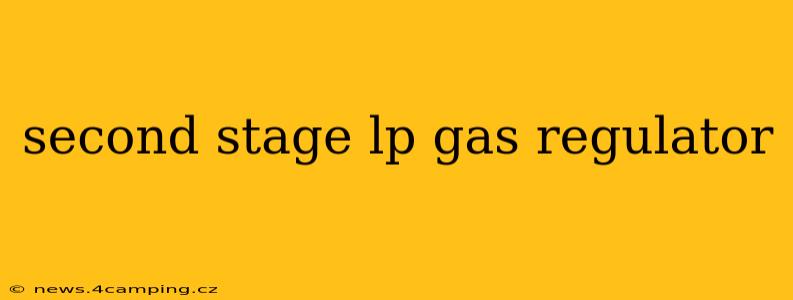LPG, or liquefied petroleum gas, is a widely used fuel for cooking and heating. To safely and efficiently use LPG, a two-stage regulator system is employed. This guide delves into the crucial role of the second-stage regulator, explaining its function, components, safety features, and troubleshooting tips.
What is a Second Stage LPG Regulator?
The second stage regulator is the component that reduces the gas pressure from the intermediate pressure (provided by the first-stage regulator) to a safe and usable pressure for your appliance. Think of it as the final gatekeeper before the gas reaches your stove, heater, or other LPG-powered device. It's a critical safety element, preventing dangerous pressure surges that could lead to leaks or explosions.
How Does a Second Stage LPG Regulator Work?
The process involves several key steps:
-
Intermediate Pressure Input: The regulator receives gas at a relatively low, but still significant, intermediate pressure from the first-stage regulator.
-
Pressure Reduction: The heart of the second-stage regulator is a diaphragm and spring mechanism. This mechanism precisely reduces the intermediate pressure to a much lower, appliance-ready pressure (typically around 28 mbar or 0.28 kPa).
-
Gas Flow Control: The diaphragm's movement, controlled by the spring and inlet pressure, regulates the flow of gas to the appliance. This ensures a consistent and safe gas supply, preventing over-pressurization.
-
Output to Appliance: The regulated, low-pressure gas then flows to your appliance via the outlet connection.
What are the Components of a Second Stage LPG Regulator?
A typical second-stage regulator consists of:
- Inlet Port: Connects to the first-stage regulator.
- Diaphragm: A flexible membrane that responds to changes in pressure.
- Spring: Provides the opposing force to the diaphragm, controlling the pressure reduction.
- Valve: Controls gas flow based on the diaphragm's position.
- Outlet Port: Connects to the gas appliance.
- Pressure Gauge (sometimes): Indicates the output pressure of the regulator.
Why is the Second Stage Regulator Important for Safety?
The second-stage regulator is paramount for safety because it:
- Reduces Pressure to Safe Levels: Prevents dangerous pressure build-up in your appliance.
- Controls Gas Flow: Prevents gas from flowing uncontrollably.
- Protects Against Leaks: A malfunctioning second-stage regulator can often shut off the gas supply, preventing potential leaks.
How Often Should I Replace My Second Stage LPG Regulator?
While there's no single definitive timeframe for replacement, it's recommended to inspect your regulator regularly for signs of wear and tear, such as cracks, damage, or leaks. If you notice any issues, replace the regulator immediately. It is generally best practice to replace your regulator every few years or as per manufacturer recommendations. Remember, regular maintenance and replacement are vital for ensuring safety.
What are the Signs of a Faulty Second Stage LPG Regulator?
Several signs might indicate a problem with your second-stage regulator:
- Unusual Noises: Hissing or whistling sounds from the regulator.
- Weak or Inconsistent Gas Flow: Difficulties lighting the appliance or inconsistent flames.
- Gas Leaks: A smell of gas around the regulator.
Note: If you suspect a faulty regulator, turn off the gas supply immediately and contact a qualified gas professional. Never attempt to repair a regulator yourself.
How Do I Choose the Right Second Stage LPG Regulator?
Selecting the correct regulator depends on the type and capacity of your appliance. Always check the appliance’s specifications to ensure compatibility. The pressure rating should match the appliance's requirements.
Can I use a second-stage regulator without a first-stage regulator?
No, you should never use a second-stage regulator without a first-stage regulator. The first-stage regulator reduces the high-pressure gas from the cylinder to an intermediate pressure, which is then safely reduced to a low-pressure by the second-stage regulator. Using only a second-stage regulator is extremely dangerous and could result in serious injury or death.
This comprehensive guide provides a detailed overview of second-stage LPG regulators. Remember, safety should always be your top priority when dealing with LPG. If you have any doubts or concerns, consult a qualified gas professional.
